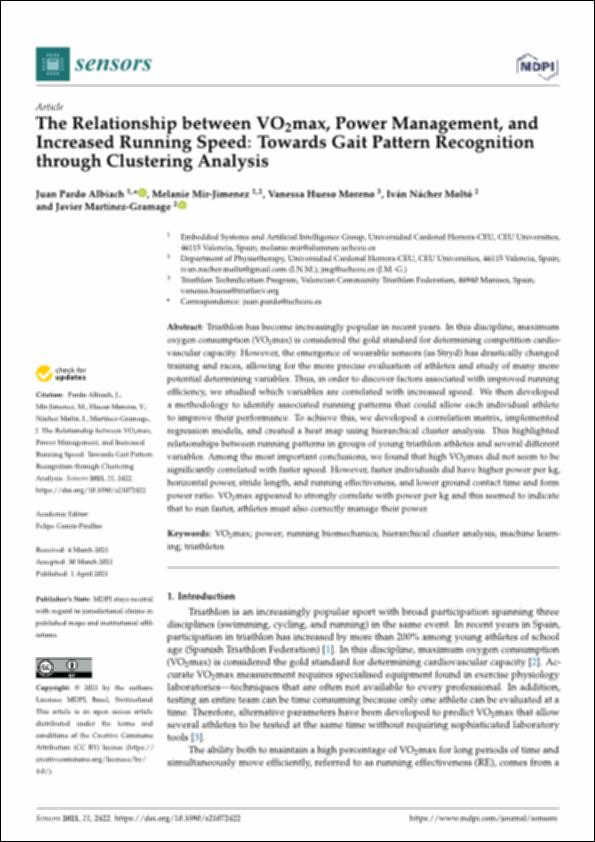Por favor, use este identificador para citar o enlazar este ítem:
http://hdl.handle.net/10637/12985The relationship between VO2max, power management, and increased running speed : towards gait pattern recognition through clustering analysis
| Título : | The relationship between VO2max, power management, and increased running speed : towards gait pattern recognition through clustering analysis |
| Autor : | Pardo Albiach, Juan Mir Jiménez, Melanie Huesa Moreno, Vanessa Nacher Moltó, Iván Martínez Gramage, Javier |
| Materias: | Fisioterapia deportiva.; Sports physical therapy.; Running races - Physiological aspects.; Biomechanics.; Carreras (Atletismo) - Aspectos fisiológicos.; Biomecánica. |
| Editorial : | MDPI |
| Citación : | Pardo Albiach, J., Mir-Jimenez, M., Hueso Moreno, V., Nácher Moltó, I. & Martínez-Gramage, J. (2021). The relationship between VO2max, power management, and increased running speed: towards gait pattern recognition through clustering analysis. Sensors, vol. 21, art. 2422 (01 apr.). DOI: https://doi.org/10.3390/s21072422 |
| Resumen : | Triathlon has become increasingly popular in recent years. In this discipline, maximum oxygen consumption (VO2max) is considered the gold standard for determining competition cardiovascular capacity. However, the emergence of wearable sensors (as Stryd) has drastically changed training and races, allowing for the more precise evaluation of athletes and study of many more potential determining variables. Thus, in order to discover factors associated with improved running efficiency, we studied which variables are correlated with increased speed. We then developed a methodology to identify associated running patterns that could allow each individual athlete to improve their performance. To achieve this, we developed a correlation matrix, implemented regression models, and created a heat map using hierarchical cluster analysis. This highlighted relationships between running patterns in groups of young triathlon athletes and several different variables. Among the most important conclusions, we found that high VO2max did not seem to be significantly correlated with faster speed. However, faster individuals did have higher power per kg, horizontal power, stride length, and running effectiveness, and lower ground contact time and form power ratio. VO2max appeared to strongly correlate with power per kg and this seemed to indicate that to run faster, athletes must also correctly manage their power. |
| Descripción : | Este artículo se encuentra disponible en la siguiente URL: https://www.mdpi.com/1424-8220/21/7/2422 Este artículo pertenece la número especial "Wearable Sensors & Gait". |
| URI : | http://hdl.handle.net/10637/12985 |
| Derechos: | http://creativecommons.org/licenses/by/4.0/deed.es |
| ISSN : | 1424-8220 (Electrónico) |
| Fecha de publicación : | 1-abr-2021 |
| Centro : | Universidad Cardenal Herrera-CEU |
| Aparece en las colecciones: | Dpto. Enfermería y Fisioterapia |
Los ítems de DSpace están protegidos por copyright, con todos los derechos reservados, a menos que se indique lo contrario.


